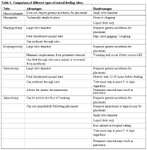Placing and caring for feeding tubes (Proceedings)
Nutritional support is indicated in cases of acute weight loss, persistent inappetence, malnutrition, increased metabolic demand, ongoing metabolic loss, or if the animal is physically unable to eat.
General Concepts
Nutritional support is indicated in cases of acute weight loss, persistent inappetence, malnutrition, increased metabolic demand, ongoing metabolic loss, or if the animal is physically unable to eat. Enteral nutrition is always favored over parenteral nutrition as it is safer, more physiologic, and more economical. Providing enteral nutrition prevents villous atrophy, stimulates antibody production, and prevents bacterial translocation from the gastrointestinal tract to the systemic circulation. Most feeding tubes are technically simple to place, but there are significant differences between all of the options. As a general rule, the closer one comes to the oral route of food intake and digestion, the more efficient is the assimilation and digestion of nutrients and the greater the flexibility in formula composition. Conversely, the further aboral one gets, the less efficient is the assimilation and digestion of nutrients and greater care must be taken when choosing formula composition. Route of administration also dictates feeding tube diameter; tube diameter in turn dictates usable feeding formulas due to varying formula viscosity and particulate matter size. The most common routes of administration for enteral hyperalimentation include oral, nasoesophageal, pharyngostomy, esophagostomy, gastrostomy, gastroduodenostomy, and jejunostomy. Each route has its indications, contraindications, advantages, disadvantages, and complications.
Nasoesophageal / Nasogastric
Nasoesophageal or nasogastric feeding tubes are an easy, effective, and efficient means of providing enteral nutritional support. The availability of small bore, soft polyvinyl and silastic feeding tubes and low viscosity, nutritionally complete liquid diet formulations, as well as patient tolerance of tube placement has made nasoesophageal tube placement a popular avenue for feeding patients. Nasoesophageal tube placement is indicated in any patient with malnutrition or inappetance that is not currently vomiting. Tubes can be placed without the need of general anesthesia, which is a big advantage in the critical patient. However, tube diameter is small which limits the types of diets that be fed through the tube. Complications include vomiting, tube clogging, or inadvertent airway placement.
Esophagostomy Tubes
Esophagostomy tubes (E-tubes) can be extremely beneficial in inappetant dogs and cats. Clinical scenarios where E-tubes may be indicated include, but are not limited to, severe upper respiratory infection, oropharyngeal tumors, and hepatic lipidosis. E-tubes are not indicated in animals with esophageal disease or in those that are actively vomiting. Advantages of E-tubes tubes over other methods of tube feeding are that these tubes are relatively simple and inexpensive to place, the animals can be fed once fully recovered from anesthesia, blended canned diets and most medications can be fed through the tube, and there are minimal problems if the tube is removed prematurely. However, general anesthesia is required for placement. Complications associated with E-tubes include vomiting (if the tube is placed such that it crosses the lower esophageal sphincter), stoma irritation or abscessation, and tube clogging.
Gastrostomy Tubes
Tube gastrostomy is indicated in anorexic patients with a functional gastrointestinal tract distal to the esophagus or patients undergoing operations of the oral cavity, larynx, pharynx, or esophagus. Gastrostomy tube placement is contraindicated in patients with primary gastric disease (e.g., gastritis, gastric ulceration, gastric neoplasia) or disorders causing vomiting. The advantages of gastrostomy tube feeding include ease of tube placement, patient tolerance, use of large bore feeding tubes, and ease of tube care and feeding by the client. Disadvantages include the need for general anesthesia, the 12 to 24 hours delay in feeding after tube placement, the need for the tube to remain in place for 7 to 14 days even if the animal is meeting its caloric requirements orally. Premature removal can result in life-threatening peritonitis.
Jejunostomy Tubes
Jejunostomy tube feeding is indicated in any patient undergoing oral, pharyngeal, esophageal, gastric, pancreatic, duodenal, or biliary tract surgery in which the intestinal tract distal to the surgical site is functional. Patients with preexisting malnutrition or severe inappetance that must undergo major abdominal surgery are considered candidates for early enteral nutritional supplementation via jejunostomy tube. Disadvantages of jejunostomy tube are that general anesthesia and laparotomy are required for placement, tube diameter is small and limits type of diet that can be administered, and that premature removal may result in life-threatening complications.

Table 1. Comparison of different types of enteral feeding tubes.